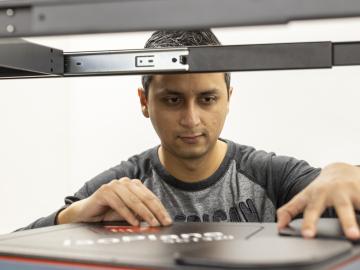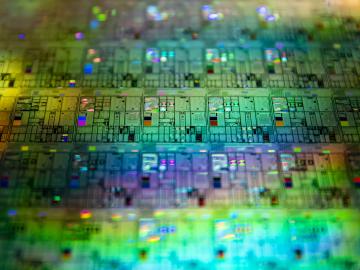
Filter News
Area of Research
- (-) Electricity and Smart Grid (3)
- (-) Nuclear Science and Technology (13)
- (-) Sensors and Controls (1)
- (-) Supercomputing (57)
- (-) Transportation Systems (2)
- Advanced Manufacturing (3)
- Biology and Environment (21)
- Computational Engineering (1)
- Computer Science (9)
- Energy Frontier Research Centers (1)
- Energy Science (111)
- Functional Materials for Energy (1)
- Fusion and Fission (26)
- Fusion Energy (15)
- Isotope Development and Production (1)
- Isotopes (4)
- Materials (70)
- Materials for Computing (14)
- National Security (22)
- Neutron Science (26)
- Quantum information Science (9)
News Topics
- (-) Fusion (9)
- (-) Grid (7)
- (-) Machine Learning (15)
- (-) Nanotechnology (11)
- (-) Quantum Science (25)
- (-) Space Exploration (8)
- (-) Transportation (8)
- 3-D Printing/Advanced Manufacturing (8)
- Advanced Reactors (12)
- Artificial Intelligence (37)
- Big Data (22)
- Bioenergy (9)
- Biology (11)
- Biomedical (19)
- Biotechnology (2)
- Buildings (4)
- Chemical Sciences (5)
- Computer Science (97)
- Coronavirus (14)
- Critical Materials (3)
- Cybersecurity (9)
- Energy Storage (8)
- Environment (23)
- Exascale Computing (26)
- Frontier (32)
- High-Performance Computing (43)
- Isotopes (7)
- Materials (15)
- Materials Science (20)
- Mathematics (2)
- Microelectronics (1)
- Microscopy (7)
- Molten Salt (5)
- National Security (8)
- Neutron Science (17)
- Nuclear Energy (39)
- Partnerships (1)
- Physics (10)
- Polymers (2)
- Quantum Computing (20)
- Security (7)
- Simulation (16)
- Software (1)
- Summit (43)
Media Contacts

For the second year in a row, a team from the Department of Energy’s Oak Ridge and Los Alamos national laboratories led a demonstration hosted by EPB, a community-based utility and telecommunications company serving Chattanooga, Tennessee.

In the early 2000s, high-performance computing experts repurposed GPUs — common video game console components used to speed up image rendering and other time-consuming tasks

In the race to identify solutions to the COVID-19 pandemic, researchers at the Department of Energy’s Oak Ridge National Laboratory are joining the fight by applying expertise in computational science, advanced manufacturing, data science and neutron science.

As a teenager, Kat Royston had a lot of questions. Then an advanced-placement class in physics convinced her all the answers were out there.

The techniques Theodore Biewer and his colleagues are using to measure whether plasma has the right conditions to create fusion have been around awhile.

We have a data problem. Humanity is now generating more data than it can handle; more sensors, smartphones, and devices of all types are coming online every day and contributing to the ever-growing global dataset.

The prospect of simulating a fusion plasma is a step closer to reality thanks to a new computational tool developed by scientists in fusion physics, computer science and mathematics at ORNL.

A team from the ORNL has conducted a series of experiments to gain a better understanding of quantum mechanics and pursue advances in quantum networking and quantum computing, which could lead to practical applications in cybersecurity and other areas.

As scientists study approaches to best sustain a fusion reactor, a team led by Oak Ridge National Laboratory investigated injecting shattered argon pellets into a super-hot plasma, when needed, to protect the reactor’s interior wall from high-energy runaway electrons.

Students often participate in internships and receive formal training in their chosen career fields during college, but some pursue professional development opportunities even earlier.


